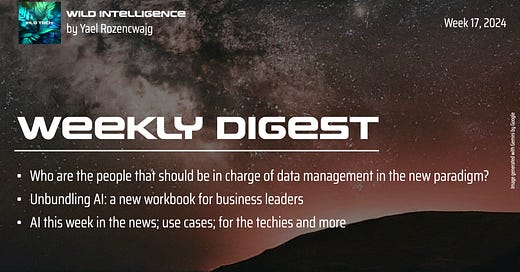📨 Weekly digest | Who are the people that should be in charge of data management in the new paradigm
What's your cross-functional approach | AI this week in the news; use cases; for the techies

Hello friends,
The digital age has brought an explosion of data, and how we manage it needs to evolve.
In this new era of AI and everything automated, strong data management is no longer just a best practice; it's necessary. In today's data-driven world, effectively managing your information assets is critical for building customer trust, making informed decisions, and gaining a competitive edge. Not to forget that building a culture of shared responsibility is key.
But can you be confident your current data practices are “optimised” to meet these challenges?
By empowering a collaborative team – including a Chief Data Officer (CDO1) to provide leadership and vision, data owners from various business units to understand the context and usage of specific data sets, data stewards to champion data quality and accessibility, security teams to safeguard information, and IT operations to manage the infrastructure.
How can we ensure data privacy, compliance, and security while deriving valuable business insights from your information?
A cross-functional approach to foster trust and breaks down silos is needed, enabling your organization to leverage the power of data with confidence. However, what seems obvious to us is not necessarily true for many organization leaders.
While the importance of a cross-functional approach to data management seems intuitive, it's not always implemented effectively. While there isn't a single statistic that directly addresses leadership buy-in, there is data that reflects the challenges of siloed data and lack of collaboration. Here are a couple of findings:
Studies show that up to 85% of data organizations collect goes unused2. This suggests a significant breakdown between data collection and its practical application, potentially due to departmental silos and lack of collaboration.
A recent IBM study found that only 37% of respondents said their companies have a well-defined data governance strategy3. This indicates a gap between understanding the need for data governance and actually implementing it, potentially due to a lack of leadership prioritization or cross-functional collaboration.
While these don't provide a specific percentage of resistant leaders, they do highlight the prevalence of data silos and the need for improved collaboration, which a cross-functional approach can address.
In the new paradigm of data management, responsibility shifts from a siloed approach to a more collaborative one. Here's a breakdown of the key players:
Chief data officer (CDO): The CDO provides overall leadership and vision for data governance and strategy. They ensure data is collected, stored, protected, and used effectively across the organization.
Data owners: These are business leaders responsible for specific data sets within their domain. They understand the data's context and usage within their department and collaborate with the data governance team to ensure compliance and responsible use.
Data stewards: Data stewards act as champions for specific data sets. They ensure data quality, accuracy, and accessibility for authorized users within their area.
Data governance team: This team, often led by the CDO, defines policies, procedures, and standards for data management. They work with data owners and stewards to implement these practices.
Data analysts and scientists: These specialists use data to generate insights and drive business decisions. They understand data privacy regulations and work within the established governance framework.
Security team: The security team plays a crucial role in safeguarding data throughout its lifecycle. They implement security controls, monitor for threats, and ensure compliance with relevant security standards.
IT operations: The IT team is responsible for the technical infrastructure that stores and manages data. They work closely with the security team to maintain a secure environment.
Everyone in the organization: In the new paradigm, everyone plays a part in data security and responsible use. Employees should be aware of data privacy regulations, understand best practices for handling sensitive data, and report any suspicious activity.
This collaborative approach ensures that data management considers various perspectives – business needs, data privacy, security, and technical feasibility. It fosters a culture of data ownership and accountability across the organization.
What do you think?
If you haven't already, you can start with our workbook, Building a data-driven organization.
I am looking forward to reading your thoughts in a comment.
Happy days,
Yael et al.
🦾 AI elsewhere on the interweb
Adobe Premiere Pro is getting generative AI video tools — and hopefully OpenAI’s Sora on The Verge
France's Mistral AI seeks funding at $5 bln valuation, The Information reports on Reuters
Microsoft announced VASA, a new tool for generating a video of a talking head from a sample photo
Fast access to our weekly posts
🚀 Unbundling AI
🎲 Data and trends
🚨❓ Big question
📨 Weekly digest
You are receiving this email because you signed up for Sustainability Insights by Yael Rozencwajg. Thank you for being so interested in our newsletter!
Weekly digest are part of Sustainability Insights, approaches and strategies.
We share tips to help you lead, launch and grow your sustainable enterprise.
Become a premium member, and get our tools to start building your AI based- enterprise.
Not a premium?
Thank you for being a subscriber and for your ongoing support.
If you haven’t already, consider becoming a paying subscriber and joining our growing community.
To support this work for free, consider “liking” this post by tapping the heart icon, sharing it on social media, and/or forwarding it to a friend.
Every little bit helps!
A better way to put your data to work on Harvard Business News
What is data governance? on IBM






